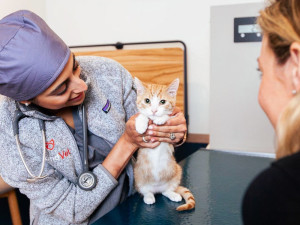How Pet Hospice Can Help When It’s Nearly Time
Veterinary hospice and palliative care expert Dr. Shea Cox, DVM, on an alternative to euthanasia.

Share Article
When our pets are young and healthy, it seems as though we have all the time in the world with them — long park walks, snuggles on the couch, even picking up poop seems like it’ll last forever. But, as it always does, time catches up with us. For many pet parents, our companion animals are so integral to our lives that when they cross over the “rainbow bridge,” it affects us similarly to the loss of human family members. However, the heart-wrenching words “nothing else can be done” do not mean that euthanasia is the only option. As they move into the closing stages of their lives, dogs and cats can benefit from animal hospice, and so can their humans.
The Goal of Pet Hospice Care
Like hospice for humans, the animal version exists to provide support and care during the last phase of an incurable disease or at the natural end of life; its primary goal is to manage pain. As such, hospice care is geared toward maintaining comfort and ensuring the highest quality of life possible during a time that may be measured in months, weeks, or days.

Save on the litter with color-changing tech that helps you better care for your cat.
Hospice focuses on creating a safe, loving, and intimate end-of-life experience in a familiar setting. This approach also gives us time to plan, grieve, and — perhaps most importantly — allow our best friends to spend their final days at home rather than in a hospital setting. This interval can be invaluable, as it helps us come to grips with our pet’s condition and say goodbye in our own way.
Though it can be rewarding, hospice care does require preparation and effort. The first step is to connect with a veterinarian who is comfortable with the concept (not all are): They will guide you in how to best provide for your pet’s needs, and in setting up a care plan to carry out at home: administering medications, supplying nutritional support, recognizing pain, implementing proper nursing care, and tuning into your dog or cat’s general emotional and physical state. If you are unsure about taking on these kinds of responsibilities, you may be able to employ a vet technician to assist you as needed.
One of the most important aspects of hospice care is pain management. Because it is easier to prevent pain than to relieve it, a multimodal approach — in which a variety of methods, including various classes of pain medications, natural supplements, acupuncture, and massage therapy are employed — is usually best. Part of this protocol involves monitoring your pet’s behavior and physical state, since agitation and vocalization may be signs of pain. In providing hospice care, you are the eyes and ears of the veterinary team, recording changes in your pet’s weight, temperature, eating habits, mobility, and other characteristics, then reporting them to your vet so that interventions or adjustments to the care plan can be made in a timely manner.
Knowing When It’s Time
When it comes to end-of-life matters, we are faced with the difficult decision of allowing for a natural death or intervening with humane euthanasia; for some, a natural death is preferable to euthanasia as long as no suffering is involved. The decision if and when to euthanize is as individual and personal as the relationship between you and your dog or cat. You have spent their lifetime learning to communicate by reading body language and developing a unique bond. Attend to what they may be trying to tell you and, above all, trust your heart.
Identifying the point at which your pet’s quality of life has irrevocably ebbed requires personal courage and sacrifice, and many people fear they will not be able to recognize when the time is right. Seek guidance in the decision-making process from family members and friends, as well as from your veterinarian, all of whom share a bond with your dog or cat. You will need the support of those who truly understand both of you.
After months (or more) of caring for a pet in declining health, it can often be difficult to decide when the end has come, which is why it is helpful to determine ahead of time the point at which you feel that their quality of life is no longer acceptable. This may be when they cease to find joy in eating, no longer enjoy interaction and connection, can no longer stand or walk, or when pain begins to be difficult to control. It is often helpful to consider good days versus bad days; more bad days than good is another indicator that the time is near. By establishing these criteria in advance, you are better prepared to make the appropriate decision, since emotion can cloud your thinking during the difficult final days of your pet’s life.
Hospice can be a wonderful, caring option. Regardless of how you choose to navigate this stage, it is good to know that it exists. Whether we opt for a natural death or a peaceful euthanasia, hospice care not only allows our pets to live out the remainder of their lives as fully as possible, it also allows them to embark upon their final journey with dignity while surrounded by love in the comfort of their familiar home environment. Hospice care is truly a gift, both to our pets and to ourselves.
Hospice Resources
The American Association of Human-Animal Bond Veterinariansopens in a new tab
The HABA website contains numerous information links for human as well as animal hospice issues.
Argus Institute, Colorado State Universityopens in a new tab
This vet school program is a pioneer in helping pet owners manage the caring for a sick animal.
International Association of Animal Hospice and Palliative Careopens in a new tab
For a listing for hospice-care help in your area, see the IAAHPC’s provider directory.
Alice Villalobos, DVM, DPNAPopens in a new tab
Dr. Villalobos is best known for treating cancer; you can also find her Quality of Life Scaleopens in a new tab for dogs and cats on her website.

Dr. Shea Cox, DVM, CVPP, CHPV
Dr. Shea Cox is the founder of BluePearl Pet Hospice and is a global leader in animal hospice and palliative care. With a focus on technology, innovation and education, her efforts are changing the end-of-life landscape in veterinary medicine.
Related articles
![Portrait Of Large, Senior, Mixed Breed Dog On Beach]() opens in a new tab
opens in a new tabHow to Grieve a Pet
For National Pet Memorial Day — Sept. 12th — we asked 5 grief experts how to cope with feelings of guilt after we lose a pet.
![A smiling veterinarian holding a cat]() opens in a new tab
opens in a new tabVets Are at High Risk For Compassion Fatigue—Here Are 4 Ways You Can Help
It’s extra important to be nice to the vet in your life.

